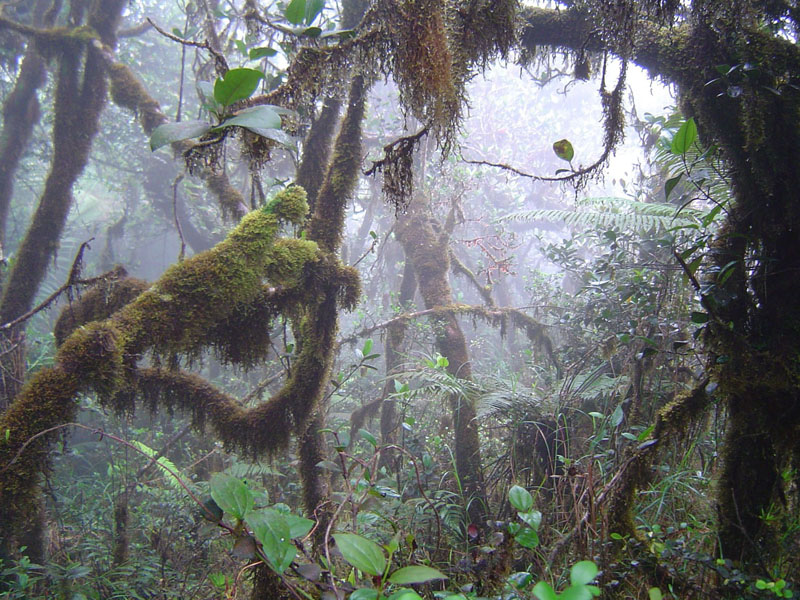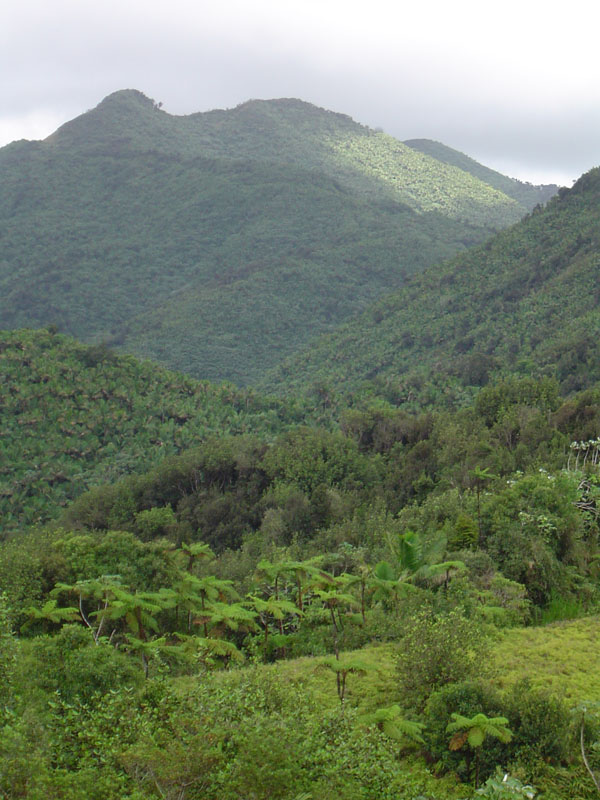Media contact: Dan Krotz, (510) 486-4019, [email protected]
In September 1989, Hurricane Hugo slammed into the east coast of Puerto Rico with winds exceeding 140 m.p.h. The storm uprooted trees and underbrush, leveling wide swaths of the Luquillo Experimental Forest, which has been a center of tropical forestry research for nearly a century.
Just four years later, however, there were no signs of devastation. Instead of a graveyard of decaying trees, only a thin layer of leaves carpeted the forest floor. Acres of fallen biomass were replaced by a healthy rainforest.

All that biomass, and the rainforest floor is coated by a thin layer of dead leaves. The microbes responsible for this Herculean decomposition task could help usher in a new era of cleaner energy sources. (image: Kristen DeAngelis)
“It looked like the storm never happened,” says microbiologist Kristen DeAngelis, a Seaborg postdoctoral fellow in Berkeley Lab’s Earth Sciences Division.
How did the rainforest so quickly and completely rid itself of the storm-tossed biomass? The answer lies in the soil, where microbial communities ravenously decompose every tree, vine, and leaf that falls to the ground. DeAngelis and colleagues have spent the past few years canvassing Luquillo to learn more about these microbial communities, which rank among the most efficient biomass break-down engines on Earth. Harnessing their power could lead to improved ways of converting plant material into biofuels.
“Microbial communities in the rainforest soil may hold clues to new ways of breaking down plant biomass,” says DeAngelis, who is collaborating with Terry Hazen, a leading microbial ecologist in Berkeley Lab’s Earth Sciences Division; and Whendee Silver, a biogeochemist in UC Berkeley’s Department of Environmental Science, Policy and Management.
DeAngelis’ work is funded in part by the U.S. Department of Energy Joint BioEnergy Institute (JBEI), whose mission is to advance the development of the next generation of biofuels – liquid fuels derived from the solar energy stored in plant biomass. A critical step in biofuel production is deconstructing plant material, or lignocellulose, into sugars that can be converted into bio-ethanol and other advanced biofuels. As part of this research, JBEI scientists are scouring microbial communities for especially potent deconstructive enzymes.

Switch grass buried at different elevations -- from wet, cool mountains to dryer, warmer lowlands -- will help scientists pinpoint the optimum conditions for biomass decomposition. (image: Kristen DeAngelis)
Their quest has led them to the rain-soaked mountains of Luquillo. Wet subtropical forests such as those in Puerto Rico have some the highest rates of biomass decomposition of any ecosystem on the planet, which is why rainforest floors aren’t littered with debris. This record-setting pace should indicate feast conditions for soil-bound microbial communities, but it’s really a matter of survival. Tropical forest soil is poor in nutrients, forcing microbes to quickly scavenge from whatever falls from above before it’s washed away.
“The microbes need to get as much carbon as they can out of biomass as quickly as possible. It’s a biological imperative,” says DeAngelis.
Tropical forest soils are also among the oldest on Earth. The microbial communities in Luquillo’s soil have had between 40 and 60 million years of evolutionary selection to optimize the rapid and complete decomposition of plant material. Nothing is left behind.
To better understand this hidden world, DeAngelis and colleagues have buried mesh bags filled with switch grass — a promising biofuels feedstock — at several sites throughout Luquillo. Some bags are buried at high elevation sites that are wet and cool. Others are buried at low elevation sites that are warmer and receive less rain (three meters per year instead of five meters per year). Analyses of these samples will help scientists determine the environmental factors that control decomposition rates. The bags of switch grass also serve as “microbe traps,” which enable the scientists to conduct a census of the microbes that break down biomass, as well as identify the most efficient bacteria and fungi.
Among the tools used in this research is the Phylochip, a matchbox-sized microarray developed at Berkeley Lab that can quickly detect the presence of up to 9,000 species of microbes in specially prepared samples. The team also developed a similar tool, called the MycoChip, which can rapidly identify more than 11,000 fungal taxa.

The research team in the rainforest. From left: Kristen DeAngelis, Julian Fortney of Berkeley Lab's Earth Sciences Division, and Whendee Silver of UC Berkeley.
In other work, scientists at Berkeley Lab are incubating switch grass and soil communities taken from Luquillo under different conditions, such as with and without oxygen. This allows the team to home in on the parameters that best drive biomass decomposition.
The scientists are also amassing inventories of the genes in Luquillo’s microbial communities, which will help them pinpoint the enzymes responsible for breaking down lignocellulose. This work is conducted at the Department of Energy’s Joint Genome Institute, which carries out sequencing projects that accelerate research in energy, agriculture and carbon sequestration.
“Tropical forest soils could serve as a reservoir for new biomass-decomposing microorganisms — and we’re starting to identify the key microbes and enzymes,” says DeAngelis.
The Luquillo Experimental Forest, located at the northeastern end of Puerto Rico, is home to many scientific studies on biodiversity, land use, and climate change. View Puerto Rico in a larger map